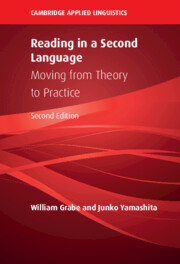Book contents
- Reading in a Second Language
- The Cambridge Applied Linguistics Series
- Reading in a Second Language
- Copyright page
- Dedication
- Contents
- Figures
- Tables
- Preface
- Part I Foundations of Reading
- Part II Patterns of Variation in Reading
- Part III Developing Reading Comprehension Abilities
- 11 Vocabulary and Reading Comprehension
- 12 Building Main Idea Comprehension: Syntax and Strategies
- 13 Becoming a Strategic Reader
- 14 Building Awareness of Discourse Structure
- Part IV Expanding Reading Comprehension Skills
- Part V Applications of Reading Research: Instruction and Assessment
- References
- Author Index
- Subject Index
13 - Becoming a Strategic Reader
from Part III - Developing Reading Comprehension Abilities
Published online by Cambridge University Press: 01 September 2022
- Reading in a Second Language
- The Cambridge Applied Linguistics Series
- Reading in a Second Language
- Copyright page
- Dedication
- Contents
- Figures
- Tables
- Preface
- Part I Foundations of Reading
- Part II Patterns of Variation in Reading
- Part III Developing Reading Comprehension Abilities
- 11 Vocabulary and Reading Comprehension
- 12 Building Main Idea Comprehension: Syntax and Strategies
- 13 Becoming a Strategic Reader
- 14 Building Awareness of Discourse Structure
- Part IV Expanding Reading Comprehension Skills
- Part V Applications of Reading Research: Instruction and Assessment
- References
- Author Index
- Subject Index
Summary
Chapter 13: Becoming a Strategic Reader. This chapter focuses on the development of the strategic reader, rather than strategies themselves. Strategic readers automatically and routinely apply combinations of effective and appropriate strategies, depending on reader goals, reading tasks, texts being read, and strategic processing abilities. Strategic readers are also aware of their comprehension success in relation to reading goals and apply sets of strategies appropriately to enhance comprehension with difficult texts. Becoming a strategic reader is challenging and requires considerable instruction and support. The chapter reviews research involving several instructional approaches to develop strategic processing, including Collaborative Strategic Reading (CSR), Questioning the Author, Transactional Strategies Instruction (TSI), Promoting Adolescent Comprehension of Text (PACT), and Concept-Oriented Reading Instruction (CORI). The chapter then links strategic reading to the challenges of advanced “reading to learn” goals, and concludes with implications for instruction.
Keywords
- Type
- Chapter
- Information
- Reading in a Second LanguageMoving from Theory to Practice, pp. 312 - 337Publisher: Cambridge University PressPrint publication year: 2022

